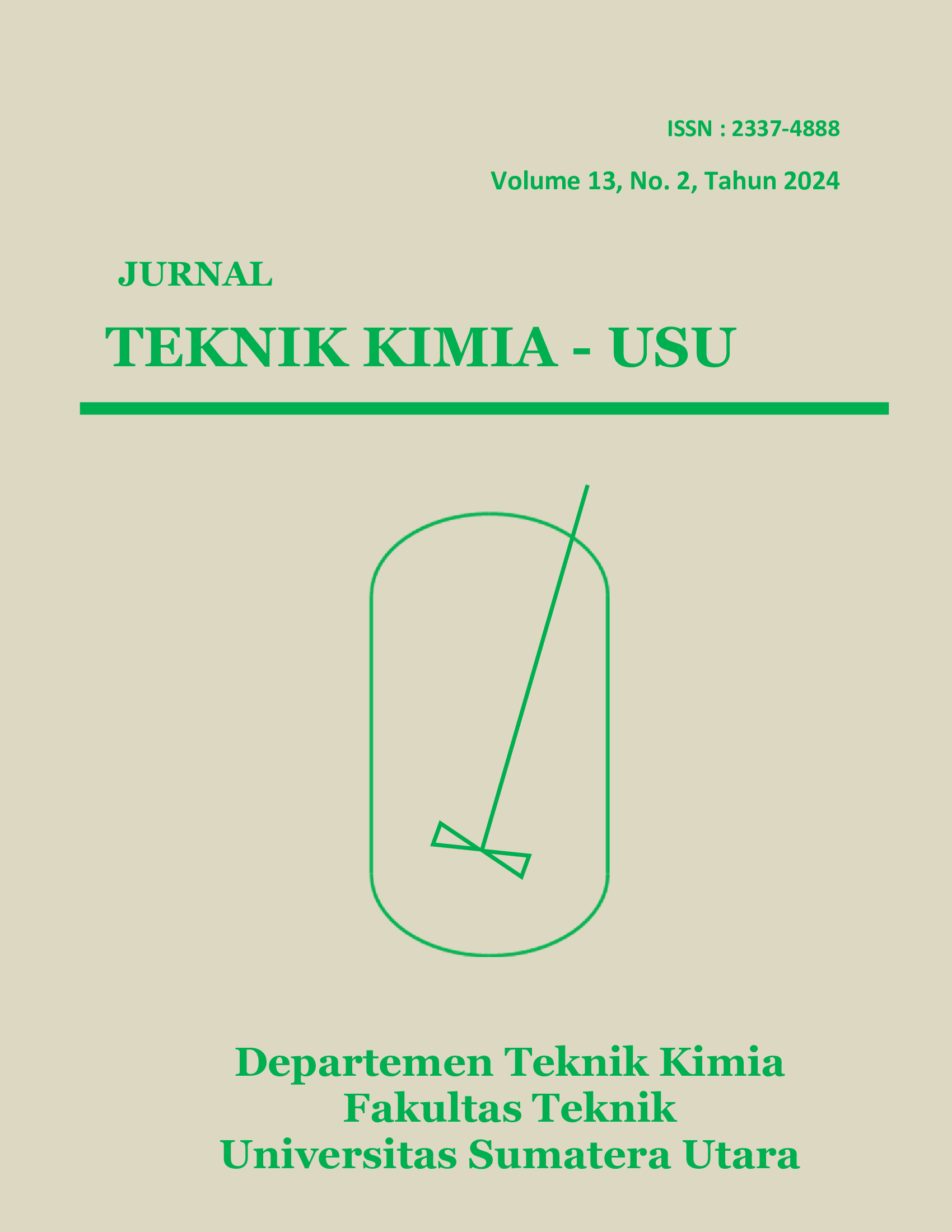Ekstraksi Daun Kejibeling (Strobilanthes crispus) dengan Metode Continuous Ultrasound-Assisted Enzymatic Extraction: Pengaruh Temperatur dan Konsentrasi Enzim
DOI:
https://doi.org/10.32734/jtk.v13i2.17151Keywords:
continuous ultrasound-assisted enzymatic extraction, strobilanthes crispus, total flavonoid content, total phenolic contentAbstract
Continuous ultrasound-assisted enzymatic extraction (CUAEE) method has become a promising technique for extracting bioactive compounds from plant materials. In this study, the extraction of kejibeling (Strobilanthes crispus) leaves was carried out using the CUAEE method to optimize the extract yield. The experimental design involved extraction parameters including leaf particle size (d ≤0,177 mm), ethanol concentration (50%), extraction time (180 minutes), and varying parameters such as temperature (30 °C, 40 °C, 50 °C, and 60 °C), as well as cellulase enzyme concentration of 3% and 5%. The results showed that the optimal conditions for CUAEE were achieved at a temperature of 60 °C with an enzyme-solid ratio of 5%, producing a total phenolic content (TPC) of 12,097 mg EAG/g dry leaf powder and a total flavonoid content (TFC) of 2,291 EK/g dry leaf powder. The data obtained indicate that the continuous ultrasound-assisted enzymatic extraction method has the potential for large-scale production of phenolic acids and flavonoids.
Downloads
References
V. Ramadhani, R. Rusdi, Z. Azizah, and H. Rivai, “Overview of phytochemicals and pharmacological activity of keji beling plant (Strobilanthes crispus Bl.),†International Journal of Pharmaceutical Sciences and Medicine, vol. 6, no. 7, pp. 25–39, Jul. 2021, doi: 10.47760/ijpsm.2021.v06i07.003.
N. S. Muslim, K. W. Ng, A. Itam, Z. D. Nassar, Z. Ismail, and A. M. S. A. Majid, “Evaluation of cytotoxic, anti-angiogenic and antioxidang properties of standardized extracts of strobilanthes crispus leaves,†International Journal of Pharmacology, vol. 6, no. 5, pp. 591–591, 2010.
N. A. Norfarizan-Hanoon, R. Asmah, M. Y. Rokiah, O. Fauziah, and H. Faridah, “Antihyperglycemic, hypolipidemic and antioxidant enzymes effect of strobilanthes crispus juice in normal and streptozotocin-induced diabetic male and female rats,†International Journal of Pharmacology, vol. 5, no. 3, pp. 200–207, 2009.
F. Abd Rachman, P. Kadar Kolesterol Pada Tikus Putih Jantan Galur Wistar, and S. Ardiansyah, “Ekstrak Daun Keji Beling (Strobilanthes crispus L.) Untuk Penurunan Kadar Kolesterol Pada Tikus Putih Jantan (Rattus norvegicus) Galur Wistar,†Journal of Medical Laboratory Science Technology, vol. 2, no. 1, pp. 1-5, Jul. 2019, doi: 10.21070/medicra.v2i1.1648.
D. Lin et al., “An overview of plant phenolic compounds and their importance in human nutrition and management of type 2 diabetes,†Oct. 01, 2016, MDPI AG. doi: 10.3390/molecules21101374.
P. K. Ningtyas, T. S. Utami, Y. Muharam, and R. Arbianti, “Extraction of phenolic compounds from strobilanthes crispus with continuous ultrasound assisted extraction as antihypercholesterol drug preparation,†in AIP Conference Proceedings, American Institute of Physics Inc., Sep. 2023. doi: 10.1063/5.0165014.
A. Ullah et al., “Important flavonoids and their role as a therapeutic agent,†Nov. 01, 2020, MDPI AG. doi: 10.3390/molecules25225243.
M. S. Liza et al., “Supercritical carbon dioxide extraction of bioactive flavonoid from Strobilanthes crispus (Pecah Kaca),†Jun. 01, 2010, Institution of Chemical Engineers. doi: 10.1016/j.fbp.2009.02.001.
L. Y. Yong, “Composition and Biological Activities of Strobilanthes Crispus Leaves for Essential Oils Extracted by Hydrodistillation (HD) and Microwave-Assisted Hydrodistillation (MAHD) Methods,†2016.
M. P. Casas and H. DomÃnguez González, “Enzyme-Assisted Aqueous Extraction Processes,†in Water Extraction of Bioactive Compounds: From Plants to Drug Development, Elsevier, 2017, pp. 333–368. doi: 10.1016/B978-0-12-809380-1.00013-9.
Z. Pan, W. Qu, H. Ma, G. G. Atungulu, and T. H. McHugh, “Continuous and pulsed ultrasound-assisted extractions of antioxidants from pomegranate peel,†Ultrason Sonochem, vol. 19, no. 2, pp. 365–372, 2012, doi: 10.1016/j.ultsonch.2011.05.015.
R. Arbianti, H. Ningsih, N. F. Putri, T. S. Utami, Y. Muharam, and Slamet, “A comparative study of sequential and simultaneous enzymatic and ultrasound-assisted aqueous two-phase extraction for anticholesterol compounds from Strobilanthes crispus leaves,†Pak J Pharm Sci, vol. 37, no. 2, p. 265, 2024, doi: 10.36721/PJPS.2024.37.2.REG.265-274.1.
M. Puri, D. Sharma, and C. J. Barrow, “Enzyme-assisted extraction of bioactives from plants,†Trends in Biotechnology, vol. 30, no. 1, pp. 37-44, Jan. 2012, doi: 10.1016/j.tibtech.2011.06.014.
Angelina, M. Yumna, Abdullah, R. Arbianti, T. S. Utami, and H. Hermansyah, “The usage of enzyme in ultrasound-assisted enzymatic extraction method and its effect on yield extract from Keji Beling (Strobilanthes crispus.) leaves,†in E3S Web of Conferences, EDP Sciences, Nov. 2018. doi: 10.1051/e3sconf/20186703002.
S. Margaretta, S. D. Handayani, N. Indraswati, and H. Hindarso, “Ekstraksi senyawa phenolic pandanus amaryllifolius roxb. sebagai antioksidan alami.†Widya Teknik, vol. 10, no. 1, pp. 21-30, 2011, doi: 10.33508/wt.v10i1.157.
A. P. Ghandahari Yazdi, M. Barzegar, M. A. Sahari, and H. Ahmadi Gavlighi, “Optimization of the enzyme-assisted aqueous extraction of phenolic compounds from pistachio green hull,†Food Sci Nutr, vol. 7, no. 1, pp. 356–366, Jan. 2019, doi: 10.1002/fsn3.900.
D. Huang, X. Zhou, J. Si, X. Gong, and S. Wang, “Studies on cellulase-ultrasonic assisted extraction technology for flavonoids from Illicium verum residues,†Chem Cent J, vol. 10, no. 1, Sep. 2016, doi: 10.1186/s13065-016-0202-z.
A. Poedjiadi, M. Wirahadikusuma, and D. Kunia, Dasar-dasar biokimia, XI. Jakarta: UI-Press, 1994.
R. Saeed, D. Ahmed, and M. Mushtaq, “Ultrasound-aided enzyme-assisted efficient extraction of bioactive compounds from Gymnema sylvestre and optimization as per response surface methodology,†Sustain Chem Pharm, vol. 29, p. 100818, Oct. 2022, doi: 10.1016/j.scp.2022.100818.
I. Hanifah, “Optimasi selulase pada enzyme assisted extraction lemak dari caulerpa lentillifera menggunakan response surface methodology,†Jurnal Ilmu dan Teknologi Kelautan Tropis, vol. 13, no. 1, pp. 19–37, Apr. 2021, doi: 10.29244/jitkt.v13i1.32654.
K. Kumar, S. Srivastav, and V. S. Sharanagat, “Ultrasound assisted extraction (UAE) of bioactive compounds from fruit and vegetable processing by-products: A review,†Jan. 01, 2021, Elsevier B.V. doi: 10.1016/j.ultsonch.2020.105325.
Downloads
Published
Issue
Section
License
Copyright (c) 2024 Jurnal Teknik Kimia USU

This work is licensed under a Creative Commons Attribution-ShareAlike 4.0 International License.

















